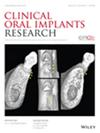磷酸钙种植体周围移植能改善种植体的骨整合吗?一项实验性体内研究。
IF 5.3
1区 医学
Q1 DENTISTRY, ORAL SURGERY & MEDICINE
引用次数: 0
摘要
目的:本体内研究旨在评估纳米结构羟基磷灰石(HAnano)涂层或双酸蚀(DAA)表面的牙种植体在低密度骨羊模型中的骨整合,在种植体周围间隙中植入或不植入磷酸钙。材料与方法将30个假体(HAnano 15个,DAA 15个)植入5只2-4岁绵羊的髂骨。每只动物放置6个植入物:2个采用异种移植生物材料,2个采用同种异体生物材料,2个不采用移植(对照组)。显微层析分析评估了所有组的骨和生物材料的百分比。组织形态计量学分析评估骨-种植体接触(BIC)、骨占据面积分数(BAFo)和8周愈合期后生物材料的存在。数据分析采用重复测量方差分析或混合效应模型,显著性水平为0.05。结果愈合期间无并发症发生。所有小组的平均BIC为55%,范围从4.6%到67.7%不等。BAFo平均占30%,生物材料占22%,结缔组织占44%。移植物组与非移植物组在BIC (p = 0.413)、BAFo (p = 0.097)、结缔组织存在(p = 0.192)以及骨和生物材料百分比(p = 0.959)、骨百分比(p = 0.283)或生物材料百分比(p > 0.0959)方面差异均无统计学意义。结论同种异体或同种异体生物材料在种植体周围小缺损中的骨整合效果不明显。这些结果表明,在这种情况下,自发愈合可能就足够了。本文章由计算机程序翻译,如有差异,请以英文原文为准。
Does Calcium Phosphate Peri-Implant Grafting Improve Osseointegration of Dental Implants? An Experimental In Vivo Study.
OBJECTIVE
This in vivo study aimed to evaluate the osseointegration of dental implants with a nanostructured hydroxyapatite (HAnano) coating or a double acid-etched (DAA) surface, grafted with or without calcium phosphate in the peri-implant gap, in low-density bone in a sheep model.
MATERIALS AND METHODS
Thirty implants (15 HAnano and 15 DAA) were installed in the iliac crest of five sheep (2-4 years old). Six implants were placed per animal: two with a xenograft biomaterial, two with an alloplastic biomaterial, and two without grafting (control). Microtomographic analyses evaluated the percentage of bone and biomaterial for all groups. Histomorphometric analysis assessed bone-implant contact (BIC), bone occupied area fraction (BAFo), and biomaterial presence after an 8-week healing period. Data were analyzed using repeated-measures ANOVA or mixed-effects models with a significance level of 0.05.
RESULTS
No complications were observed during the healing period. The average BIC across all groups was 55%, ranging from 4.6% to 67.7%. BAFo averaged 30%, with biomaterial occupying 22% and connective tissue 44% of the interface area. There were no statistically significant differences between grafted and non-grafted groups for BIC (p = 0.413), BAFo (p = 0.097), connective tissue presence (p = 0.192), and for the percentage of bone and biomaterial (p = 0.959), bone percentage (p = 0.283), or biomaterial percentage (p > 0.0959).
CONCLUSION
Peri-implant grafting with xenograft or alloplastic biomaterials did not significantly enhance osseointegration compared to ungrafted implants in small peri-implant defects. These results suggest that spontaneous healing may suffice in such cases.
求助全文
通过发布文献求助,成功后即可免费获取论文全文。
去求助
来源期刊

Clinical Oral Implants Research
医学-工程:生物医学
CiteScore
7.70
自引率
11.60%
发文量
149
审稿时长
3 months
期刊介绍:
Clinical Oral Implants Research conveys scientific progress in the field of implant dentistry and its related areas to clinicians, teachers and researchers concerned with the application of this information for the benefit of patients in need of oral implants. The journal addresses itself to clinicians, general practitioners, periodontists, oral and maxillofacial surgeons and prosthodontists, as well as to teachers, academicians and scholars involved in the education of professionals and in the scientific promotion of the field of implant dentistry.
 求助内容:
求助内容: 应助结果提醒方式:
应助结果提醒方式:


